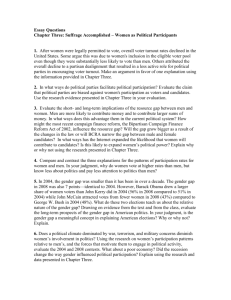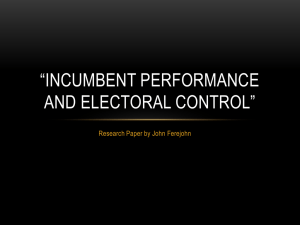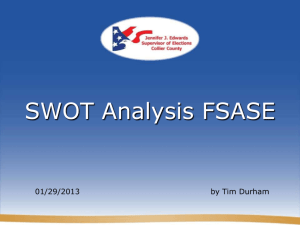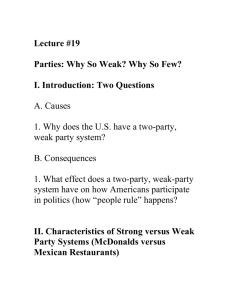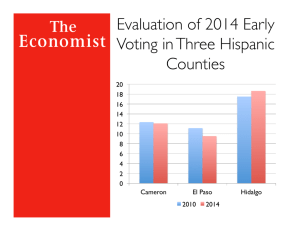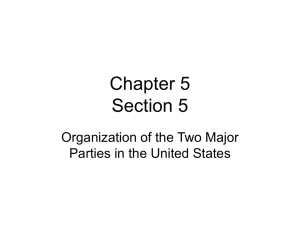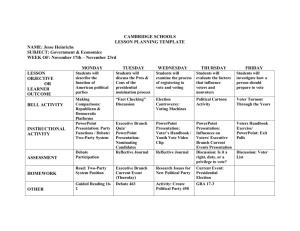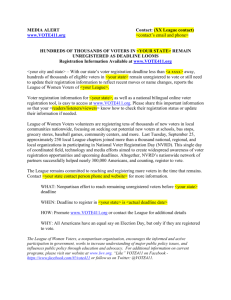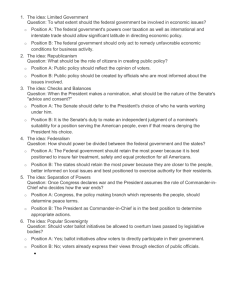Retrospective Voting: An Experimental Study
advertisement
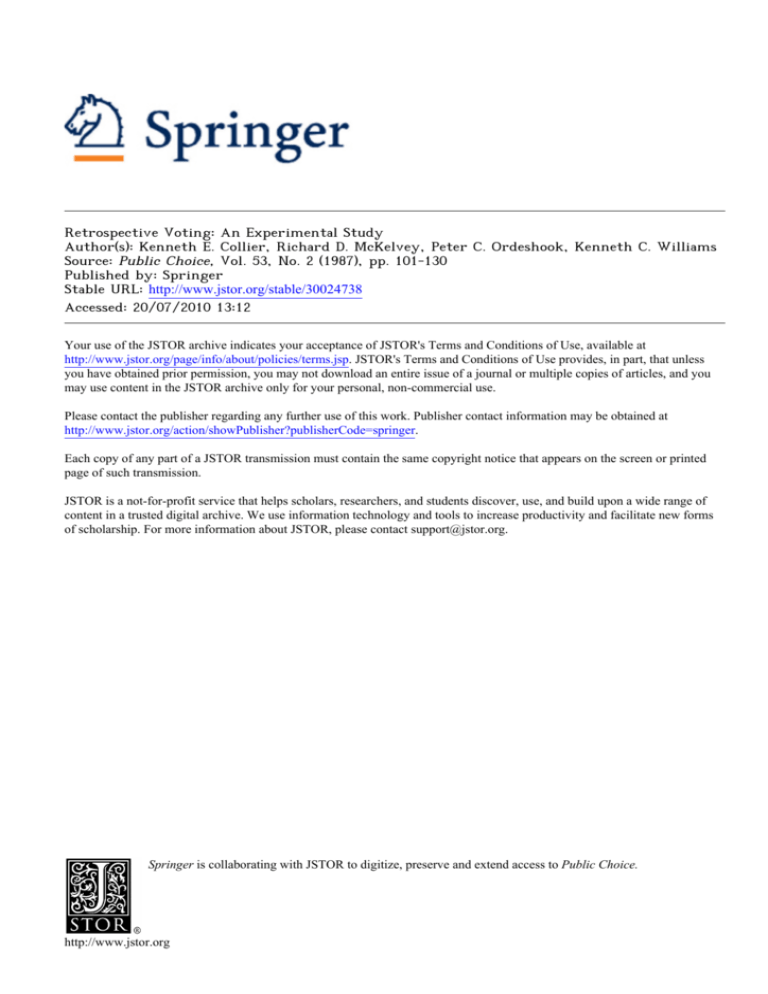
Retrospective Voting: An Experimental Study
Author(s): Kenneth E. Collier, Richard D. McKelvey, Peter C. Ordeshook, Kenneth C. Williams
Source: Public Choice, Vol. 53, No. 2 (1987), pp. 101-130
Published by: Springer
Stable URL: http://www.jstor.org/stable/30024738
Accessed: 20/07/2010 13:12
Your use of the JSTOR archive indicates your acceptance of JSTOR's Terms and Conditions of Use, available at
http://www.jstor.org/page/info/about/policies/terms.jsp. JSTOR's Terms and Conditions of Use provides, in part, that unless
you have obtained prior permission, you may not download an entire issue of a journal or multiple copies of articles, and you
may use content in the JSTOR archive only for your personal, non-commercial use.
Please contact the publisher regarding any further use of this work. Publisher contact information may be obtained at
http://www.jstor.org/action/showPublisher?publisherCode=springer.
Each copy of any part of a JSTOR transmission must contain the same copyright notice that appears on the screen or printed
page of such transmission.
JSTOR is a not-for-profit service that helps scholars, researchers, and students discover, use, and build upon a wide range of
content in a trusted digital archive. We use information technology and tools to increase productivity and facilitate new forms
of scholarship. For more information about JSTOR, please contact support@jstor.org.
Springer is collaborating with JSTOR to digitize, preserve and extend access to Public Choice.
http://www.jstor.org
Public Choice53: 101-130(1987)
@ 1987MartinusNijhoff Publishers,Dordrecht- Printedin the Netherlands
Retrospectivevoting: An experimentalstudy
KENNETHE. COLLIER
University of Texas at Austin
RICHARDD. McKELVEY
California Institute of Technology
PETERC. ORDESHOOK
University of Texas at Austin
KENNETHC. WILLIAMS*
University of Texas at Austin
Abstract
This essay reports on some experiments designed to study two candidate electoral competition
when voters are 'retrospective' voters. The experiments consist of a sequence of elections in
which subjects play the part of both voters and candidates. In each election the incumbent
adopts a policy position in a one-dimensional policy space, and voters are paid (on the basis
of single peaked utility function over that space) for the position adopted by the incumbent.
Neither voters nor candidates are informed of the voter utility functions, and the only information received by the voter is the payoff he has received from the present and previous incumbent
administrations. Despite the severely limited information of candidates and voters, we find
that, generally, candidates converge toward the median voter ideal point.
1. Introduction
It is well known that most voters are poorly informed about candidates'
policy positions and party platforms, about the substantive content and
conceptualization of issues, and about how alternative positions on those
issues relate to their specific welfares. Confronted with such facts, the classical Downsian spatial model seems an untenable abstraction. Because it is
difficult to justify empirically assumptions such as that citizens vote 'for the
candidate whose policy position is nearest their ideal point,' or 'for the candidate whose policy position yields the greatest expected utility,' it is tempting to regard models that use such assumptions as irrelevant to understanding democratic processes.
Instead, the empirical data provides more support for a 'retrospective
voting' model in which voters have minimal information about contempo*We acknowledge support of NSF Grants No. SES-84-09654 to the California Institute of
Technology, and No. SES-84-09245 to the University of Texas at Austin.
102
rary issues and candidatepositions, and where voters base their voting
decisionson the performanceof past administrations.As V.O. Key (1966)
writes:
[The empirical data] ... graphically reflect the electorate in its great,
and perhapsprincipal,role as an appraiserof past events, past performance, and past actions. It judges retrospectively;it commands
prospectivelyonly insofaras it expresseseitherapprovalor disapproval
of that which has happenedbefore.
Accordingto the retrospectivevotinghypothesis,then, votersmay know
nothingof the policypositionsadoptedduringthe currentcampaignby the
incumbentand challengingcandidates.Indeed, in drawingthe distinction
betweenthe 'traditional'and 'Downsian'views of retrospection,Fiorina
(1981)notes that in the traditionalversiona voter need not even know the
policy positionsof past administrations,or have any conceptualizationof
issues. Instead,votersneed only know how well off they were duringprevious administrations.
This essay does not explorethe extent to whichthe retrospectivevoting
hypothesisexplainscitizens' decisions, or which view of restrospectionis
more consonantwi,:hthose decisions.We are concerned,instead, with the
implicationsof retrospectivevotingfor candidates,and for the policiesthey
are likelyto implementif elected. Specifically,we are concernedwith how
well the political process works vis-a-visthe spatial positions adopted by
incumbentsif voters are forced to choose retrospectively.
In thisessay,ther.,we reporton someexperimentsin whichwe givevoters
only the informationthat they areassumedto use underan extremeversion
of the traditionaldefinitionof retrospection,and we test whetheroutcomes
and the decisions made by voters and candidatesare different from the
outcomes and deci;sionsthat would occur if everyonehad the complete
informationcommonlyassumedin spatialmodelsof elections.In our analysis we also examinehow voters form theirevaluationsof incumbentsand
challengersif they are given informationonly about theirutilityfrom past
incumbents.Seconcd,we look at how incumbentschoose policypositionsin
the incompleteinformationsettinggeneratedby retrospectivevoting.
Elsewhere,we examine two types of incompleteinformationelection
models, and we show theoreticallyand experimentallythat in both of those
models, electionswill achievethe sameoutcomeas theircompleteinformation counterparts.Those papersdiffer from this workin severalways. The
first model (McKelhey and Ordeshook, 1985a) focuses on a single election,
and contrary to the extreme form of the retrospective voting hypothesis, it
assumes that voters use contemporaneous information from interest group
endorsements, public opinion polls, and the advice of friends. The second
103
model(McKelveyand Ordeshook,1985b)morecloselyparallelsthe Downsian perspectiveon retrospection,and givesvotersmoreinformationabout
issuesand candidatesthan the traditionalretrospectivehypothesisadmits.
That model assumesthat votersobservethe actualpolicy positionsof past
incumbents,as well as a contemporaneousendorsementthat tells votersthe
left-rightorientationof the two candidateson the electionissue.
Both our previous papers demonstratethat the political process can
functionwith incompleteinformation,but we cannot use these modelsto
evaluate the traditionalretrospectivevoting hypothesis. First, if as Key
asserts,the electorate'commandsprospectivelyonly insofaras it expresses
either approvalor disapprovalof that which has happenedbefore,' then
eventsof the currentcampaignareirrelevantto a voter'sdecision,including
the endorsementsof interestgroupsand the candidates'avowedpositions
on issues. We can interpreta campaignas an opportunityfor voters to
gather information to 'fine-tune' their retrospectiveevaluations of an
incumbentcandidate(cf. McKelveyand Ordeshook, 1985a). But in the
extreme form of the hypothesis, the only informationthat a voter has
concerns the past performanceof incumbents,the currentincumbent's
performance,or the historicalperformanceof the challenger'spartyrelative
to the voter's welfare. Second, while our earliermodels supposethat both
electioncandidateshavewell definedpositionson the issuesand that voters
estimatethese positions indirectly,retrospectivevoting supposesthat citizensvote on the basisof answersto questionsuchas: 'Am I betteroff today
than I was four yearsago?' Votersdo not need to know the actualpolicy
positionsof previousincumbentsor currentchallengers.In fact, the challenger'scampaignpromisesare irrelevant.Instead,only the utilityor benefit attributedto previousand the currentincumbentare relevantto voters.
In Fiorina'swords:'Whatpoliciespoliticiansfollow is theirbusiness;what
they accomplishis the voter's (p. 13)'.
This paper, then, investigatesexperimentallyelections that concern a
singleissue, in whichvotersknow only what theirwelfarehas been in previousadministrations.In ourexperiments,only incumbentsadoptpositions
on the issue. Modelingthe assumptionthat voters pay no heed to current
promisesand campaignrhetoric,a challengermustsit idly by and hope that
the incumbentmisreadsvoter desiresor that votersotherwisechoose to see
what the challengermight offer as an incumbent.Thus, for voters, any
informationabout the challengermust come from the past, and the principal decisionconfrontingvoters is whetheror not to reelectthe incumbent
on the basis of the current and past performance of the incumbent and the
past performance (if any) of the challenger. In fact, some of our experiments do not even inform voters about the existence of a campaign issue.
In the next section, 2, we review the details of our experimental procedures. Section 3 summarizes the outcomes of the experiments in terms of
104
their convergence to the full information outcome (the median voter ideal
point). In Section 4, we estimate a decision rule for voters that is suggested
by the retrospective hypothesis, and we examine the extent to which subjects
abide by such a rule. Section 5 evaluates a similar rule for the candidates.
Section 6 assesses whether these rules can be used to explain the extent to
which incumbents converged or failed to converge to median preferences.
Section 7 examines three variations in the experiments: (1) voters are told
that the election concerns a single issue and that each of them has a singlepeaked preference over this issue that determines their payoffs, (2) voters
are wholly uninformed about the basis of their payoffs, and (3) electorate's
median preference is;shifted suddenly, without voters or candidates being
told of this shift. Section 8 concludes with observations about how our experiments might be modified to address other issues about retrospective
voting and incomplete information in elections.
2. Experimental design
This essay summari2es nineteen multiple-trial experiments in which undergraduates at the University of Texas, acted both as voters and as candidates.
These experiments were structured as follows: each voter is assigned a
single-peaked utility function on an 'issue', where the issue is a numerical
scale between zero and one hundred. Voters, however, are not told their utility function. Two subjects are selected as candidates, and they also are uninformed about voter preferences. Candidates are seated in a separate
room, and with a coin toss one of them is selected as the initial incumbent.
That incumbent must then choose a position on the issue, but the position
is not revealed to the voters. Instead, each voter's payoff, based on his or
her assigned utility function evaluated at the position selected by the incumbent, is computed and revealed to the voter (payoffs range from zero to
seventy cents per voter per period). Voters must then vote on whether to
keep the current incumbent in office or to elect the challenger. The winner
becomes the new incumbent, and must choose a position in the next election
period. This process is repeated a predetermined number of periods (or until
time expires, usually two hours). The experiments varied in length from between 23 and 45 periods, with an average length of 34 periods. Each voter's
final payoff equals the total of what is earned across all periods (averaging
$14), while candidates are paid $1 for each election that they win and
nothing otherwise.
To test various hypotheses about retrospective voting, we look at three
variants of this procedure. In the first variant, voters and candidates are told
that voter preferences are single peaked, and an illustrative utility function
is shown to all subjects. In the second variant, neither voters nor candidates
105
are told about the shape of voters' preferences on the issue. Indeed, voters
are not informed about the existence of an issue. Of course, candidates must
be told about the issue since this defines their strategy space (the instructions
read to subjects in this experiment are presented in this essay's appendix).
The third variant is identical to the second except that in the twenty-first
period the ideal points of all voters are increased or decreased 35 units (depending on whether the original median is less than or greater than 50).
Neither voters nor candidates are informed of this shift, although it does
affect voter payoffs immediately.
The comparison of outcomes between the first two experimental variants
tests the hypothesis that information about one's utility function and
knowledge of the issue are irrelevant to final outcomes. Theoretically,
voters should not require the additional information about the shape of
their utility functions since they cannot use this information. The traditional
version of the retrospective voting hypothesis maintains that not only is contemporaneous information about the candidates' campaigns irrelevant to
voting decisions, but that voters have no knowledge about public policy and
the issues being debated in a campaign. The second experimental variant
models this situation, and we might even speculate that the additional information provided subjects in the first variant will confuse them as they attempt to make use of essentially irrelevant information.
The third variant tests whether candidates respond appropriately to
'shocks' to the system in the form of abrupt changes in taste. These experiments also permit us to assess better the extent to which candidates discount
the past, and adjust their beliefs about appropriate strategies to information
that is discordant with previous experience. If candidates respond 'quickly',
then we have some confidence that retrospective voting does not preclude
the selection of appropriate equilibrium strategies; but if candidates
respond 'slowly' or not at all, then retrospective voting may induce appropriate outcomes only if there is considerable long-term constancy to the
linkages between policy instruments and voters' welfares.
3. A review of the experimental outcomes
Figures 1 - 4 describe four specific experiments. The horizontal axis in each
figure denotes election periods, while the vertical axis denotes candidate positions on the election issue and the actual median preference. Squares denote an election period in which candidate 1 is the incumbent and asterisks
denote a period in which 2 is the incumbent. Thus, in Figure 1, for example,
the coin toss establishes candidate 1 as the initial incumbent and he chooses
70 as his position; but in the first vote, 1 loses, so 2 becomes the incumbent
and he choses 30, and so forth.
106
100-
n
C
u
m
b
n
t
9080
80-7060-
50
P
0
a
40:_+-.......-..
30
t
20-
o
n
1000
5
10
15
0
30
20
25
Election Period
Candidate
1
*
35
40
45
Candidate 2
Figure 1.
100 90
n
c
u
80
70
b
80
n
t
50
P
40
60
0
9
30-
t
20
o
10
n
0
0
Figure 2.
5
10
15
20
Election Period
25
30
107
100
l
c
n
u
90
80
m
b
e
n
t
70
P
40
60
50
os
30
l
t
l
o
n
20
10
00
0
5
10
15
20
Election Period
25
30
Figure 3.
100
l
n
c
u
m
b
e
n
90
80
70
60
t
50
P
40
o
s
l
t
l
o
30
20
10
0
5
10
15
20
Election Period
25
30
Figure 4.
Figure I shows an experiment in which incumbents slowly move towards
the median after an initial sequence of sharp fluctuations. Notice how the
outcomes of the initial sequence of elections guide the candidates to the
general region of the median. Presumably because extreme positions at 70
35
108
and 30 lead to the defeat of incumbents,candidate1 chooses the midpoint
50 in electionperiod3. A 'votererror'leadsto l's reelection(althoughwe
shouldkeepin mindthat votersas yet havelittle on whichto base an expectation), and somewhatfortuitously,1 then shifts towardsthe medianand
selects40. The incumbent,1, then returnsto his initiallysuccessfulstrategy,
50, and is defeated.Candidate2 fails to readhis electionas a signalto move
down, andmovesup instead,whichcauseshimto lose. The newincumbent,
1, returnsonce again to 50, but is reelectedonly once. Since strategiesin
excessof 50 haveall been unsuccessful,candidate2 readsthis as a signalto
movedown, but he over-compensates,and 1 is electedin period 10. Notice,
now, that neithercandidateever considerspositions outside of the range
(30-50). Candidatel's reelectionin period 11 might again be interpreted
as voter error,but we should keep in mind that if votersare looking back
more than one period, l's position is betteron averagefor a majority.In
period 13, however, 1 moves even furtherfrom the medianand is replaced
by 2, who once againfailsto shifttowardthe medianandis quicklyreplaced
by 1, who movesbacktowardthe median.Hence, whilethe signalssent by
voters in this experimentare not always clear in their interpretation,and
while the candidates(especially2) frequentlyerr, it is evident that the
generalconvergenceof the candidatesto the medianhereis not a chanceor
fortuitousevent. Ext:reme
incumbentslose, and as the experimentproceeds
votersbecomemoresensitiveto smallvariationsin position.Also, errorsby
one candidatehelpkeepan opponentfrommakingsimilarerrors,sincethey
convey informationabout what strategiesare likely to be successful,and
which ones are likely to yield defeat.
In contrast to Figure 1, Figure 2 presentsour most obvious 'failure'.
Here, the candidatesneverstabilizeabout any point. Actually,the signals
that voters send are generallyclear in termsof what directionthey prefer
candidatesto move, but neither candidateseems able to interpretthese
signals. Figure 3 shows an experimentthat is between the first two,
although,again,incumbentsthat defectsharplyfromthe medianaregenerally punishedwitha defeat. Whilethe convergenceto the medianis less precise than in Figure 1, it seems reasonableto suppose that if time had
permittedthis experimentto run ten or fifteen additionalperiods, Figures
1 and 3 would not look much different. Finally, Figure 4 illustratesan
experimentin whichthe medianis shiftedsuddenlyin the twenty-firstperiod
from 35 to 70. Notice that 2 is cautiouslymoving in the directionof the
medianfromperiods13to 18. In period 19, however,he choosesa position
furtherfromthe median,and is defeated.Candidate2, now the incumbent,
moves back towards the median, but is defeated unanimously in period 21,
since almost all voter payoffs suddenly decline. Candidate 2 moves sharply
up to 40, but voters, presumably remembering earlier payoffs, remain dissatisfied, and 2 loses by a vote of 6 to 1. Candidate 1 moves back to a region
109
Table 1. Convergence of incumbent's position to median
Periods
Ist 10
2nd 10
Last 10
Constant
Slope
Std. error
Std. error
of Estimate
R2
26.29
.495
.059
17.83
.698
.051
9.99
.871
.056
15.08
.27
13.19
.50
13.09
.57
13.86
10.36
9.08
11.06
10.04
10.14
Average dist.
from median
Standard dev.
of distance
of the issue that had been successfulin the past, but he again loses 7 to 0.
Convinced,perhaps,that somethinghas changed,or in confusion, the new
incumbentsuccessfullytries a radicallynew strategy,65.
These figuresillustratesome common patternsin the experiments,and
they illuminatesome of the questionswe now ask and answer.Is the experimentthat Figure2 reportstrulyan aberration?Whichexperiment,the one
that Figure2 reports,or the one that Figure 1 reports,providesthe more
reasonablecharacterizationof incompleteinformationelectionswithretrospective voting? Might incumbentshave moved closer to the median in
Figure3 if the experimenthad been run longer?
First, to answerone question, we can safely reject the hypothesisthat
convergenceto the medianis a fortuitousevent. Indeed,convergenceis the
most generalpatternthat emergesin our experiments.Pooling our data
acrossall 19 experiments,let us look first at some simpledescriptivestatistics that summarizetheseoutcomes.For example,for periods1 through10,
we find that the payoffs to the medianvoter average$.49; for periods 11
through20 this averageincreasesto $.55; and for the last ten periods it
becomes$.56 (out of a possiblemaximumof $.70), even though we have
includedthe six medianshift experimentsthat mightnot permitcandidates
sufficienttime to fully adjust to new conditions.
Table 1 presentsthis datadifferently.Thistablesummarizesthreeregressions in whichthe actualmedianis the independentvariable,and in which
the dependentvariableis the incumbentcandidate'spositionsin the firstten
periods, periods 11 through 20, and the last ten periods. This table also
presentsthe mean and varianceof the distanceof the incumbentfrom the
medianin each rangeof periods.
We can apply two null models to the estimatedcoefficientsin Table 1.
The firstis thatthereis no relationshipbetweenan incumbent'sstrategyand
110
the electorate'smedian,in whichcasethe constantis 50 andthe slopecoefficient is 0. The secondnull hypothesisis that the candidateshaveconverged
to the median,so that the constantis 0 and the slope 1. Whilewe can reject
both hypotheses,notice that as the experimentsproceed,the slope coefficient increasesfrom .50 to .87, while the estimatedinterceptdecreasesas
predictedfrom 26 to 10. The averagedistanceof the candidatesfrom the
median,moreover,is lessthanten unitsin the lastten periods.Furthermore,
the fit of each regressionimprovesmonotonicallyas the experimentproceeds (R2increasesfrom .27 to .57). Thus, whileit did not happenin every
experiment, these regressionsdocument a general convergenceto the
median.
The data in Table 1 suggeststhat incumbentswill learnto choose appropriatestrategiesin stableenvironments(that is, if the medianpreferenceis
stable). It is also interestingto note, however,that if we look solely at the
six medianshift experiments,the averagedistanceof the incumbentfrom
the medianin the last ten electionperiodsis not significantlydifferentfrom
the overallaverage.That is, candidatescan learnto tracka changingmedian. Figure4 illustratesthis tracking,but the experimentin Figure5 provides
a moredramaticexampleof the process.Notice, first,that priorto the shift,
the voters(actually,one voter)haveallowedcandidate2 to drift awayfrom
the median.One votervotes 'incorrectly'in period21, whichallowscandidate 1 to remainin office, but when 1 attemptsto drift further(now in the
directionof the shiftedmedian)he loses, sincevoterpayoffs have suddenly
declined. Candidate2, now the incumbent,wins reelectionafter moving
slightlycloserto the new median,but when he returnsto the regionof I's
earliersuccessfulpos:itionshe loses. At this point, the candidatesseemconfused, as well they mightbe, sincepositionsthat weresuccessfulin the past
are no longersuccessful.And whilethe reelectionof candidate1 in period
28 might reflecta voter error,we should keep in mind that for a majority
of voters, 1 mightappearto be the betterof two bad candidates.In period
29, the incumbentchooses a position approximatelymidwaybetweenthe
previousfour positions, whichtakes him near the new median, and which
securesfor him a stringof reelectionvictoriesuntilperiod42. But, the more
extremepositionsof 2 leadto his eventualreplacementby 1 in the lastperiod
of the experiment.
The previous examples should not be interpretedto mean that when
convergenceoccurs,it occurssmoothlyor quickly,or that whenthe candidates move in the 'wrong'direction,it is becauseof voter errors.Figure6
illustratesan experimentin which, despite seeminglycorrectsignals from
voters, the candidates confuse themselves for a while. Notice, first, that
after candidate 1 moves past the median in period 5 and is replaced by 2,
2 is defeated after only a slight (one unit) move away from the median. The
new incumbent, 1, reasonably reads this as a signal to move to a lower
111
100-l
n
c
u
90
80
m
b
a
n
t
70
p
o
s
l
40
t
1
o
n
60
50
30
20
10
0
0
5
10
15
30
20
25
Election Period
35
40
45
Figure 5.
100
l
n
c
u
m
b
e
n
t
90
80
70
60
50
P
40
0
s
30
l
t
l
o
n
20
10
0
0
5
10
20
15
Election Period
25
30
Figure 6.
position, is reelectedin period9, then inexplicablyshifts to 20. Candidate
2 movesbackto the regionof previouslysuccessfulstrategies,and then, he
too shifts too low, whereuponthe voters elect 1, who gains reelectionby
moving back to the median in period 13. But again, 1 chooses a radical
35
112
positionand is defeated.Candidate2 is then ableto securea stringof victories by movingtowardsthe median, until he moves too high in period 18.
Hereafter,the candidatessettle in to more cautious moves, and on four
occasionsset theirpositionsidenticallyequalto the median.Whycandidate
1 chooses the two radicalpositionsin periods 10 and 14 is unclear,but as
we note earlier, it illustratesthat convergencedoes not always follow a
smooth path.
The convergenceto the medianthatTable 1 reportsgivesour earlierquestions some focus. Now we must ask: is therea theoreticaljustificationfor
supposing that, despite the incompleteinformationin our experiments,
incumbentsshouldconvergeto the medianvoteridealpoint?Whatdecision
rulecan we attributeto candidatesthat impliesconvergence?Second, what
explainsvoterdecisions?Why, for examplein Figure5, does the electorate
permitcandidate1 to move towardsand away from the medianin periods
29 through40, but a slight move off the medianin period41 leads to the
election of the challenger?
To shed some light on possibleanswersto these questions,we now turn
to separateanalysesof voters and candidates.Aside from showing that
retrospectivevoting and incompleteinformationdo not precludeconvergence to complete informationoutcomes, these analyses should give us
some insightinto how votersuse retrospectiveinformation,and how candidates respondto an electoratethat votes retrospectively.
4. Voters
To analyzevoterswe must first introducesome notation. We let ct E( 1,2)
denote the incumbentin election period t, and we let st e X = [0,100]
denotethe policy positionadoptedby ct in periodt. Each voter has a symmetricsingle-peakedutilityfunction,ui(s),overX, withan idealpoint at
xi,
and a voter's payoff in period t is ui(st). In our experiments,voter i observesui(st),but not ui or st. Thus, in the currentperioda voter knows his
welfareunderthe currentadministration,but he does not observehis own
utilityfunctionor the incumbent'spoliciesor strategy.Finally,in addition
to observing ui(st) for the current period, voters also know ui(st-1)9
Ui(St-2), and so forth. That is, voters are awareof the streamof benefits
that they have receivedfrom each previousincumbent.
The questionwe address,now, is: How do votersuse this benefitstream
(ui(st), ui(st-1),...) in deciding how to vote in the current election? The
retrospective voting hypothesis suggests a 'reward and punishment' rule, in
which the incumbent is rewarded if a voter believes that he has performed
'well', and is punished (with a vote for the challenger) if the voter believes
that the incumbent has performed 'poorly'. In our experimental context, we
113
can considerseveralways to identifywhat 'well' and 'poorly'mightmean.
First,a votermightsimplycomparethe incumbentagainstthe performance
of the previousadministration.That is:
if ui(st) > ui(st_1), then vote for the incumbent,ct;
otherwisevote for the challenger.
(4.1)
In Presidentialelectionsthis voter asks the question:'AmI at least as well
off today as I was four yearsago?', and if he answers'yes', then he votes
for the incumbent,otherwisehe votes for the incumbent'sopponent. But
this decisionrule is merelya specialcase of a more generalrule. Suppose
voter i discounts the past at the rate ri in establishingan evaluation of
what he can expectto receivefrom incumbents.Beginningat some initial
period,sayj = 1, and countingup to periodsj = t- 1, this votercomputes,
t
EVi (t) = ri E (1 -ri)J-lui(stj)
j=1
=ri
Ui(st-1)
+ (1 -ri)tEVi(0)
+ (1-ri)EVi (t-1)
(4.2)
If ui(st) > EVi (t), then i votes for the incumbent,otherwisei votes for
the challenger.Thus, if ri = 1, then this voter comparesonly the current
and previouselection periods, whereasif ri = 0, then he weightsall past
outcomesequallywhen makingthis comparison.
There is, however, another model of voter decisions that we should
consider:a model in which voters discriminatebetween the candidates'
performances.In this instance,the voter computestwo discountedvalues
- one for eachcandidate.Unlikeexpression(4.2), however,the discounted
value, EVi (t), for the currentincumbent,j, looks only at those periods
in which j is the incumbent;similarly,the discountedvalue, EVk(t), for
k x j looks at those periodsin which k is the incumbent.More formally,
supposecandidate1 is the incumbentin the currentperiodt, in whichcase
voter i should use the following formulato updatediscountedvalues:
EVi (t) = (1 - ri)k EVi (t - 1) + [1 - (1 - ri)k Ui(St)
EV (t) = EV2 (t - 1)
(4.3)
wherek is the numberof periodssince 1 was the incumbentlast. Hence,
i votes for the currentincumbentif EV' (t) > EV2(t), otherwisehe votes
for the challenger(or tosses a coin if equalityholds).
Combiningall experimentaltrials, performinga grid search over the
value of r and initial expectation,EV(0), that best fits the data for each
114
voter, we find that 87%of all voterdecisionsare consistentwiththe model
impliedby expression(4.2), and 80%areconsistentwith the modelimplied
by expression(4.3). Thus, despitethe limitedinformationof votersabout
the structureof the experiments,they act in coherentways. But, sinceboth
models are reasonable,it is possible that different subjectsuse different
criteria.Thus,if we choosethe modelthat best fits eachsubjectin an experiment, we find that 88%of all decisionsareconsistentwithone modelor the
other. And, of the nearly 200 subject observations,the simple rewardpunishmentmodel - the expectationsmodel impliedby (4.2) - fits best
nearlythree-quartersof the time. Overallthen, subjectsseem to be simply
comparingthe payoff fromthe currentincumbentwitha discountedstream
of benefitsfromthe past. If the currentpayoff exceedsthe stream,theyvote
to reelectthe incumbent;if the currentpayoff falls shortof the stream,they
vote to unseatthe incumbentin favor of the challenger.
Sinceit providesthe overallbetterfit, we focus on the model impliedby
expression(4.2). With this focus, we can then let EV(0) be the average
payoff each subjectreceivesin some initial numberof 'learning'periods,
whichsomewhatarbitrarily,we set equalto six. Nevertheless,one difficulty
with evaluatingdecision rules is that the estimate of r for some voters,
dependingon the incumbents'strategies,is indeterminate.Some specific
cases illustratethis as well as the generalpatternswe find in our experiments. Figures7, 8, 9, and 10 plot the payoffs of four voters across all
periodsin four experiments.Circlesdenoteincumbentsfor whom the subject voted, x's denote incumbentsfor whom the subjectdid not vote, and
the dashed line representsthe expectationat the estimateddiscount rate
from previousincumbents.Thus, circlesabove and x's below the dashed
line denote votes that are consistentwith the model from expression(4.2).
Figure7 illustratesa voter with a best-fit discount rate of .4, but who
couldjust as easilybe saidto be satisficingby votingfor any incumbentwho
pays him morethan fifty cents. Indeed,if we did not requiresettingthe initial expectationequal to what the voter receiveson averagein the first six
periods,a discountrate of 0 (satisficing)yields no errors.Figure8, on the
other hand, illustratesa voter who seems not to be satisficing, but who
instead is forced to adjust his expectationsas the experimentproceeds.
Notice that at the end of the experiment,the subject,while rewardingincumbentsthat yield him a higher payoff than the immediatepast, must
rewardincumbentsfor payoffs that earlierin the experimenthe had voted
against. Figure9 shows a voter who most clearlyillustratesa subjectwith
a high discountrate. Any payoff increaseover the previousperiod is followed by a vote for the incumbent; any decline is followed by a vote for the
challenger. There is no evidence of satisficing here. Finally, Figure 10 shows
a voter who seems to be satisficing in the first half of the experiment at $.50,
but after a series of low payoffs in trials 21 through 26 (this is one of our
115
0.7
Expectation
0.6
0.5
P
a
y
o
t
t
0.4
0.3
0.2
0.1
0
0
5
15
10
20
25
30
35
Election Period
0 Voted for Incumbent
X Voted against
Incumbent
Figure 7. Shift, r = .4, %correct = .93.
0.7
0.6
0.5
Expectation
P
a
y
o
0.4
f
0.3
t
0.2
0.1
0
0
5
10
15
20
25
30
Election Period
0 Voted for Incumbent
Figure 8. No mod., r = .4, %correct = 86.
X Voted Against
Incumbent
35
116
0.7
Expectation
0.6
0.5
P
a
0.4
y
o
f
f
0.3
0.2
0.1
0
0
10
5
15
30
25
20
Election Period
0 Voted for Incumbent
X Voted against
Incumbent
Figure 9. No mod., r = 1.0, %correct = 1.0.
0.7
Expectation
0.6
0.5
P
a
y
o
t
t
0.4
0.3
0.2
0.1
0
0
5
10
15
20
25
30
35
EJectionPeriod
0 Voted for Incumbent
Figure 10. Shift, r = 1.0, %correct = .91.
X Voted against
Incumbent
40
117
Table 2. Predicting % correct by voter
t
Independentvar.
Coefficient
Std. error
No. of periods
-.0036
.0021
1.698
r
- .1542
.0260
5.925
.0558
.0245
2.273
Pay variance
Constant = .9804 (s.e. = .1053)
Sig. level
> .001
.05
R2 = .25 (df. = 111)
median shift experiments), the subject acts as if he is looking back only one
period (i.e., r = 1.0) by rewarding any increase in payoff and by punishing
any decline, however slight. The implication of these figures, then, is that
there appears to be considerable variation among voters in the decision rules
they use, although hopefully permitting r to vary captures some of this
variation.
Although over 80% of all decisions are consistent with the reward-punishment model, there is considerable variation in the estimated r's and the range
of consistent choices among voters varies from 50% to 100%. We have no
theory that explains why some voters fit the model well in an experiment and
others fit poorly. Certainly, some subjects understood the experiment better
than others, and some learned more quickly than others. Table 2 reports a
simple regression in which the dependent variable is each voter's fit to the
model (%07COR),
and three independent variables: the number of periods in
an experiment, the value of r estimated for a voter, and the variance of the
voter's payoffs across periods. These variables yield an adjusted R2 of only
.25, which suggests that voter errors do not follow any clear pattern.
Despite the low R2, the signs of the coefficients have logical interpretations. First, high values of r reduce WoCOR.This is consistent with the fact
that if a voter satisfices (if r = 0), then that voter is not likely to make many
errors, given his or her decision rule. But if subjects abide by some more
complex rule approximated by expression (4.2), then we will generally
estimate r to be other than zero, and our model is likely to produce some
errors. Second, the significant coefficient on pay variance reflects the fact
that if candidates present the voters with stark choices, then voters are
presented with easy decisions that readily fit the model. However, if the
candidates vary their positions only slightly, then voters might consider
other criteria, such as choosing a candidate who is perceived as being less
risky because his strategies have varied less in the past. Finally, the fact that
the coefficient for number of periods is insignificant supports our subjective
evaluation that voters learned 'how to vote' in a relatively short period of
time, say ten periods, if they learned at all. In general, then, although there
is considerable variation in the decision rules used by voters (at least with
118
respectto r), subjectscan makesenseout of retrospectiveinformation.We
cannotdetermineif a subjectvoted for the 'right'candidate,becausewe do
not know what position the challengerwould have adoptedif elected. But
a significantpercentageof all decisionsareconsistentwith a simplerewardpunishmentrulesuggestedby the retrospectivehypothesisthatusesonly one
free parameter,r.
5. Candidates
An analysisof candidatesis more problematicthan the analysisof voters,
becausethe retrospectivevotinghypothesisdoes not directlyapplyto candidates, and thus does not suggesta specificrulefor how candidatesor political parties act when voters are retrospective.To evaluatethe incumbent
data, then, we assumethat incumbentsact as if they believethat the voters
are followingthe model in the previoussection, and that they try to make
inferencesabout the preferencesof the voters on the basis of their voting
behaviour.Since we are not able to work out the mathematicaldetails in
general,we consideronly the case when r = 1.0 for all voters, which correspondsto the situationin whichvotersmake theirdecisionson the basis
of whetherthe presentincumbentis doingbetteror worsethan the previous
incumbent.
If the candidatesassumethat all votersobey the modelin Section4, with
r = 1.0, then in any election period t, voters vote their true preferences
betweenthe position of the incumbentin t, st, and the position of the incumbentin periodt - 1, st 1. Since preferencesare symmetricand single
peaked,this meansthat candidatect will win if and only if the medianvoter
ideal point is closer to st than it is to st - . To make this precise we define
the set St as follows:
St = Ix':lst - xli <; lst-i 1 - x ii ) if ct+1 = Ct
St = Ix: list- x 11 >; Ist-1 - x i i if ct+1 t Ct
So, St is always a half intervalstartingat (st + st- 1)/2 and includesthe
positionof the winningcandidate.It follows that fromthe vote in periodt,
an incumbentseeking reelectioncan make the inferencethat the median
voter's ideal point is in the set St. (We ought to keep in mind throughout
this discussion, of course, that subjects were not trained about spatial
models or the equilibriumof the median, so our model actuallyassumes
more knowledgethan our subjectspossessed.)Extendingthis reasoning,it
follows that if an incumbentwere to pool the informationavailablefrom
electionperiods1 throught, then he or she shouldconcludethat the median
119
voter ideal point is in the set S* = njt
Sj.
Notice, now, that if votersreallyactedaccordingto the modelof Section
4 with a uniformdiscountrate of r = 1.0, then the sets S,. t = 2,3,...,
form a nesteddecreasingsequenceof nonemptysets that alwayscontains
the medianvoter'sideal point. Hence, if votersmakeno errors,and if r =
1 for all voters,theneventuallycandidateswill be ableto identifythe electorate'smedianpreference.But the votersdo makeerrors,and only half the
estimatedr's are greaterthan .5. Thus, thereis no guaranteethat this set,
in the later stages of an experiment,will be nonempty. To resolve this
difficulty,we supposethat the candidatesassumethat thereis as little voter
erroras possible.Specifically,for any t, we definegt(x)= I { j < t: xe Sj } I,
and define
Rt = {x: x e arg max gt(x) I.
Thatis, in periodt, the weightgivento positionx equalsthe numberof times
x has been in St, startingat t = 2 to the currentperiod. The set Rt is then
the set of all pointsthat maximizethis count. Assumingthat the incumbent
weighsall previousperiodsequally, Rt is the incumbent'sbest estimateof
the location of the medianvoter.
Likevoters, however,candidatesprobablyshouldweighrecentelections
more heavilythan more distantones, especiallyif they assumethat voters
are learningabout the experimentand how to proceed,just as they are, so
that errorsdecreaseas the experimentproceeds.Thus, as we add up the
numberof times a point x has been in St we can compute the set Rt for
variousdiscountparametersby appropriatelydiscountingthe weightgiven
past election periods.
Givena candidate's(set) estimateabout the medianpreference,we now
define the following derivativeset, which provides us with a prediction
about incumbentstrategies:
Gt = (x: IIx - y II< IIst - y IIfor all y e Rt I
Thus, adoptinga positionin Gtinsuresreelection(or a tie) regardlessof the
true position of the median in Rt, since Gt is defined to insure that any
point in it is closer to any medianin Rt than is the position of the incumbent in the previouselection period, st.
Notice, now, that if votersand candidatesmakeno errors,then positions
in this set should not only yield the continuedreelectionof the incumbent,
but also rapidconvergenceto the median. BecauseRt collapsesto the true
median, if an incumbentwishes to insurethat he or she is reelected,the
incumbentshould graduallymove towards Rt. To the extent, then, that
candidatesactuallychoose points in Gt, we have a theoreticaljustification
120
Table 3 Predicting candidate positionsa
r = 1
r = .5
r = 0
DS
DM
07oCOR
PREC
R
=
=
=
=
=
DS
DM
o7oCOR
PREC
R
5.35
4.35
4.42
6.77
7.54
8.82
.31
.43
.44
.04
.09
.12
.46
.43
.39
Average distance to G,
Average distance to midpoint of set
Percent candidate positions in set
Average precision (size relative to issue space)
Correlation of candidate position with midpoint of set
aNote that r= 1 means that only the last election is considered, while r=0 means that all
elections are weighted equally.
for concluding that the convergence to the median that Table 1 reports is
not fortuitous, but the result of a logical interpretation of the information
that retrospective voting generates.
There are several measures that we might use to evaluate the candidate's
performance with respect to Gt, and thereby estimate an appropriate (best
fit) discount rate. In the case of voters, we simply counted the proportion
of times they voted for and against incumbents who chose positions respectively above and below their discount line, choosing the discount rate to
maximize the percentage of consistent decisions. Here, however, Gt can be
small (if an incumbent chooses the same position twice and wins, Gt is a
point), and it may be unreasonable to require that an incumbent choose a
position in it as against simply near it. On the other hand, Gt can be large,
as after an incumbent chooses a radically different position, so we must also
take account of its relative size when judging a candidate's performance and
the appropriate discount rate. Finally, insofar as estimating discount rates
is concerned, we must confront the fact that while we observe a decision by
each voter in every election period, we observe decisions only of incumbents.
Rather than estimate a separate discount rate for each candidate, then,
Table 3 presents several summary measures of the candidates' aggregate
performances for three discount rates, 0, .5 and 1.0.
Notice that, although candidates choose strategies in Gt only about 43%
of the time (for r = .5), the average size of this set is about nine units. Thus,
by chance alone we would anticipate strategies in Gt only 9% of the time.
seems low when r = 0, notice
Similarly, while a 'success rate' of only 31%7o
that the size of the predicted set averages only four units. From this perspective, the success rate of Gt is more impressive, given that candidates are
subjects who are untrained about medians and equilibria. And although we
121
Table 4. Explaining reelection frequency
Variable
Coefficient
Std. error
t-statistic
DS
07oCOR
DS Opponent
%oCOR Opponent
Voter r
Constant
- .019
.059
- .001
-.002
-.345
.879
R2 = .45
.007
.113
.007
.113
.118
.077
s.e. = .128
2.91
.523
.176
.018
2.94
11.491
aggregate the data across all experiments, different candidates probably use
different discount rates, and were we to take account of this possibility, the
fit of the model would be improved considerably. Perhaps a better measure
of how well the candidates fit the model is the average distance of incumbents from Gt. Although they choose positions in the set less than half the
time, incumbents deviate from Gt on average by less than five units (for
r = .5 and 1.0).
What we lack is a reason for arguing that the candidates share the rationale of our theoretical model for choosing points in or near Gt. Since voters
do make errors even when we allow the estimate of r to differ from 1.0, it
is possible that they are following a different decision rule than what we
assume here - a rule such that leads candidates away from the median or
which implies no specific direction at all. Naturally, the most theoretically
satisfying explanation for why incumbents would track Gt is: 'because that
is the way to win.' To test this, using estimates based on r = .5, Table 4
presents a regression in which the dependent variable is the frequency of
reelection, and the independent variables are two measures of fit to the set
(DS = distance to the set, and %COR = percent of the incumbent's positions in the set), two measures of the opponent's fit, as well as the average
value of r estimated for voters in the relevant experiment (we include DS but
not DM because of collinearity between the variables, and because DS yields
a slightly better fit).
The implications of this regression are, first and as hypothesized, the relationship between DS and the frequency of reelection is significant and negative. That is, given the voter behaviour observed in the experiments, the
closer an incumbent is to Gt the greater is his or her chance of being reelected. The insignificant coefficient for %COR apparently supports our
earlier contention that Gt presents too rigorous a requirement for reelection
- getting close or moving in the direction of this set is good enough. The
failure of either measure of an opponent's fit to yield a significant coefficient is important. It suggests that an incumbent's fortunes are more a
122
function of what policieshe or she selectsthan they are of what the challengerdid in the past. Thatis, althoughan opponent'schoicewilldetermine
whethera candidateis electedor not, reelectionis more a functionof the
incumbent'sperformancethan anythingelse. Finally,the significantnegative coefficientfor r indicatesthat if voters are satisficing(low voter r), it
is easier to be reelectedthan if they are simply looking back one period.
Voterswho take the past into considerationare morelikelyto be more forgiving of deviations from Gt than are voters who look back only one
period.
Thesignificantcoefficientfor DS thatTable4 reportsconfirmsan incumbent's incentiveto choose strategiesin or nearGt. For example,being five
units furtherfrom the set, on average,decreasesan incumbent'sfrequency
of reelectionby nearly 10%. If an experimentruns 40 periods, and if a
candidateis the incumbentin half of these, then the opponentbecomesthe
incumbenttwo additionaltimes, on average.If the averagestringof victories for an incumbentis, say, threeelections,then the five unit increasein
the candidate'sdistancefrom Gt costs the candidatesix elections,or $6.00.
This seems incentiveenough to rationalizepositions in or near this set.
Before we look at whetherthe decisionrulehypothesizedfor candidates
does in fact account for strategiesnear the median, it is useful to look at
some additionalexperimentsto see why the coefficient for DS that Table
4 reportsis significantbutthe coefficientfor %CORis not. ConsiderFigure
11, whichshows an experimentin whichthe candidatesconvergedclose to
the median,andin whichbothcandidatesenjoyedlong successivereelection
periods.Notice that in lieu of stayingat a winningposition (whichinsures
choosing a position in Gt), incumbentsvary their positions slightly from
one periodto the next. When questionedafterwards,both candidatesexpresseda belief that choosingthe samepositionwouldbore the voters, and
that they would be defeated.Withrespectto the regressionin Table4, this
experimentexhibits a high percentageof reelections(89% as against an
overallaverageof 67% acrossall elections)and low averagedistancefrom
the median(1.37 unitscomparedto 4.35 overall),whichincreasesthe correlation between DS and frequencyof reelection.While the percentageof
correctdecisionsis greaterthan averagehere(52%as againstan averageof
44%), DS is 'credited'with the effect in the regression.
This is not to say that experimentssuchas the one that Figure11summarizescharacterizea majorityof our experiments.An even more frequently
observedpatternis one in whichcandidatesin fact remainat fixedpositions
for severalsuccessiveperiods.Figure12 illustratessuchan experiment,and
the lessons it reveals about retrospective voting are informative. First,
notice that keeping a fixed position does not insure indefinite reelection.
After candidate 2 has been the incumbent for five periods, the voters 'test
the waters' by electing the opponent (election period 14), who then remains
123
100
l
n
c
u
90
80
bm
70
e
n
60
t
50
P
40
o
s
l
t
l
30
20
o
10
n
0
0
5
10
15
20
Election Period
25
30
Figure 11.
100
l
n
c
u
90
80
70
m
b
e
n
t
60
P
40
50
0
a
l
t
l
o
n
30
20
10
0
0
5
10
15
Election Period
20
Figure 12.
in office for five periods, until he shifts slightly from the median in period
18. Candidate 2 is then reelected until period 24, at which time the voters
again 'test the waters,' but immediately reject I's new position.
This experiment suggests that it might be legitimate for candidates to
25
124
100
l
n
c
u
m
b
e
n
90
80
70
60
t
50
P
o
S
l
t
I
o
n
40
30
20
10
0
0
5
10
15
20
Election Period
25
30
Figure 13.
worry about the boredom of voters. But there is even a better basis for not
always wanting to be a 'fixed target'. Specifically, although 'testing the
waters' appears as an error in the model, it is not an unreasonable decision
for voters, and in fact it is one way to induce positions that are better for
a majority. Figure 13 illustrates a second experiment in which the candidates
failed to converge to the median. Notice that by testing the waters in period
22, the new incumbent, candidate 1, initially chooses a position closer to the
median. But voters reelect 1 every time thereafter, and provide the incumbent with no signals to indicate that the median is elsewhere. Thus, by
occasionally voting for the challenger after an incumbent has failed to move
for several periods, voters can hope to signal a preferred direction of change
at the next election.
Additionally, if voters suppose that candidates are learning from each
other's successes and failures, then voters should not anticipate any great
supprises when a challenger is elected. That is, if two candidates abide by
the same decision rule, then the risks of electing the challenger after a period
of stability are not great, since the challenger's strategy will not differ much
from the previous incumbent's. Hence, if we apply this lesson to real elections, then the retrospective voting hypothesis should be modified to admit
the possibility that some voters switch parties not because they are dissatisfied with an incumbent's performance, but because they wish to see if the
opposition can offer anything better, knowing that the oppostion will not
change policies radically.
35
125
6. Convergenceto the median
Table 5. Predicting convergence to the median.
Variable
Coefficient
Std. error
t-statistic
Const.
% COR for voters
DS
35.984
-40.855
1.588
R2 = .494
16.884
21.089
.412
s.e. = 5.938
2.13
1.94
3.85
Const.
COR for voters
%7o
DS
r
70.191
-73.802
1.704
- 15.876
R2 = .58
25.032
27.212
.393
8.987
s.e. = 5.580
2.804
2.712
4.339
1.767
The preceding sections detail two models of voter and incumbent candidate
choice and, theoretically, if candidates and voters abide by the models, then
convergence at the median must occur. It is useful, then, to test whether
consistency with these models, in fact, helps explain whether or not we
observe convergence. Thus, Table 5 presents the results of a simple twovariable regression in which the dependent variable is the distance of the
incumbent from the median in each experiment's last ten periods, and the
independent variables are the average distance of the candidates from Gt
(DS, using a discount rate of .5 for all candidates), and the percentage of
voter decisions that fit expression (4.2). This table also presents the results
of a second regression in which we include the average discount rate of
voters in each experiment. We include r, since, if r = 0 (if all voters satisfice), then it is possible for the model of voters and candidates to fit perfectly without implying convergence.
The most important fact of this table is that not only do the coefficients
of DS and %COR have the right signs, but, with the inclusion of r, the
coefficients for both variables are strongly significant. Of course, there may
be other models that predict voter and candidate choices as well, or better
than the models we postulate for them here, and which also imply convergence. But now we have some confidence that the convergence to the median
that Table 1 reports can be understood, in part at least, by the extent to
which voters and candidates abide by the models we postulate.
7. Threetypes of experiments
To this point we have combined all nineteen experiments into a single
126
Table 6. Some summary data comparing experiment types.
Average r
W%
Correct for voters
7o Correct for cand.
%0Incumbents reelected
Med. voter pay, last
ten periods
Med. voter pay, 2nd
ten periods
Med. voter pay, first
ten periods
Avg. distance to median,
last 10 periods
Avg. distance to median,
2nd ten periods
Avg. distance to median,
first ten periods
Average no. of periods
n
Type 1
Type 2
.50
82
44
60
$.51
79
56
69
Type 3
.59
All
.38
83
34
73
.49
82
44
67
.59
.60
.56
$.51
.60
.56
.55
$.46
.56
.47
.49
12.8
5.92
6.78
9.08
13.4
6.18
9.78
10.37
15.3
8.54
16.40
13.86
39.2
6
3.0
19
31.9
8
31.6
5
sample. This sample, however, actually contains three types: (1) experiments in which voters as well as candidatesknow the form of voter preferenceand the fact that candidatesmustcompeteon a singleissue; (2) experimentsin whichvotersare not told the basisof theirpayoffs; and (3) experimentsin whichthe medianvoterpreferenceis shiftedsuddenlyin period
21. Table 6 presentssome simple descriptivestatisticsthat we can use in
decidingwhetherthese forms produceany importanteffects. What we are
especiallyinterestedin ascertainingis, first, whetherthe additionalinformationgiven votersin experimentsof the first type aid or hindersubjects;
and, second, whethercandidatestrack a shifted median.
Althoughthereare far too few cases for meaningfulstatisticaltests (we
should keep in mind that each experimentruns approximatelytwo hours,
and costs an averageof $125), it is remarkablehow, in so many respects,
thesenumbersarealikeacrossexperimenttypes. Focusingfirst on the Type
1 andType2 experiments,the only numbersthat seemdifferentconcernthe
averagepaymentsto the medianvoter and the averagedistanceof incumbents from the median. And here the differencessuggestthat incumbents
move closerto the medianin the low informationexperimentsthanthey do
in those experimentsin whichthe basis of voter payoffs is revealedto subjects! Closerexaminationof the numbersin this table suggestsan explanation. First,noticethat whilevotersfit the modelonly slightlybetterin Type
1 experiments,the average r for voters is higher in the Type 2 trials,
127
suggestingless satisficingbehaviourin the lower informationtrials. And,
while we can only speculatewhy the additionalinformationmight cause
candidatesto performless well with respectto our model, that is in fact the
case. The combinationof candidatesthat fit the model better, and voters
who are more sensitiveto recentelection periods apparentlycombine to
yielda tighteroverallconvergencewhenirrelevantinformationis excluded.
Notice, moreover,that we cannotattributethis differenceto the fortuitous
fact that candidateson average began the low informationexperiments
closerto the medianthan they beganthe Type 1 experiments.The average
distanceof the candidatesfromthe medianin the Type3 experimentsin the
first ten periodsis actuallyslightlygreaterthan in the Type 1 experiments;
nevertheless,the averagedistanceby periods 11 through20 is less again in
the Type 3 trialsthan it is for the Type 1 trials. The summarydata on the
averagepayoffs to the medianvoter tell a similarstory. Althoughnone of
these differencesis so great that we can assertthat theoreticallyirrelevant
informationhurts, such informationclearlydoes not help either.
Examinationof the Type 3 experiments,those in which the median is
shiftedsuddenly,revealsthat sucha shift is trackedby incumbents.Because
of the shift, these experimentsare run, on average,8 periodslonger than
the others. But notice that the distanceof incumbentsfrom the medianin
the lastten periodsis not muchdifferentfromwhatwe find in the low information Type 2 experiments.
Figures4 and 5 illustratethe generalpatternin these shift experiments.
Afterthe shift, thereis a periodin whichthe candidatesappearin disequilibrium,after which they 'settle in' near the new medianor are once again
carefullyapproachingit. To see this in aggregateterms,we note that in the
first, second, third, and fourth block of five periods,the incumbents'distancefromthe medianaveraged,respectively,19.2, 13.6, 10.4and9.2 units.
In the first, second, and thirdblocksof periodsafterthe shift, this distance
averaged,respectively,19.4, 10.0 and 8.5 units. Thus, whileit took incumbents approximatelyfifteen periodsin the beginningof the experimentto
move withinten units of the median,it took them five fewerperiodsafter
the shift to accomplishthis. Clearly,our candidateshad learnedsomething
in the courseof the experimentabouthow to use the availableinformation.
And it seems reasonableto speculatethat this convergencewould be even
morerapidif candidatesanticipatedthe possibilityof periodicshifts in preferences.
8. Conclusions
Both our theoretical and experimental results should be gratifying to proponents of the retrospective voting hypothesis, and to those who do not see
128
imperfect information as an opportunity for the failure of democratic
systemsto measureand to respondto citizens' preferences.Supposethat
decisionsin accordancewith this hypothesislead to outcomes that differ
significantlyfrom what we anticipateundercompleteinformation.Then,
if voters do in fact act retrospectively,we must assumethat they do not
know the consequenceof their actions, they do not care about the consequencesof their actions, or they believethat their individualactions have
no consequences.Any one of these possibilitiesis a disquietingnote about
the functioningof democracy.
But this essay suggestssomethingquite different. Indeed, it suggestsa
kind of systemicrationalityon the partof the electorate.Giventhat one's
vote counts so little, there is little reason for people to invest in political
information.Thus, retrospectivevoting reducesinformationcosts. But it
does more. Retrospectivevotingalso yieldsthe sameoutcomeshereas does
voting withcompleteinformation,so somethingis savedwith retrospective
voting (costs), and nothing is lost (in terms of policy outcomes). And
althoughwe observeconsiderablevariationin voterand candidatedecision
rules, as well as in the abilityof subjectsto learnappropriaterules, in only
three of our nineteenexperimentsdid the candidatesfail to 'settle in' at
positions near the median.
Ourexperimentsalso revealseveralpatternsthatarereminiscentof actual
politicalphenomenona,such as voters 'testingthe waters,'and candidates
learningfrom opponentsabout reasonablestrategies.But at this point we
shoulddetailthe limitationsof our analysis.First,our experimentsconcern
a single issue. There is no reason to believe that voters cannot choose
appropriatelyin a multidimensionalenvironment(sincewe now know that
they do not requireany knowledgeof their own preferencesor the policy
space),but candidatesmay confronta differentproblem.Ultimately,then,
we shouldtest whethercandidatescan find appropriatestrategiesif multiple
issues dictatevoters' payoffs.
Second, there is no 'noise' or discordantinformationin our theory or
in our experiments.In reality,however,exogenousfactors affect the consequencesof an incumbent'spolicies. Oil embargoes,internationalconflicts, other nations' tariff policies, and the like, each affect the domestic
consequenceof an incumbent'sprogram.Thesefactorsoften are unpredictable, and even after they have occuredit may be impossibleto ascertain
whetherdifferentpoliciesmighthave producedbetterresults.If votersare
uninformed,they will not know, of course, whethertheir welfareshave
been changed by deliberatepolicies or by exogenous and uncontrollable
factors, and perhaps they will not even know that these factors exist. While
we might be able to incorporate such noise into our theoretical analysis and
show that the imperatives of convergence to the median still hold, it is less
clear how subjects in an experiment will perform. If candidates know how
129
exogenousfactorshaveaffectedtheirpositionsandthusvoters'payoffs,
Butwecanonlyguess
thentheymaybe ableto makesuitableadjustments.
howvoterswillrespondif theydeemthe candidates'unpredictable'.
thatourexperimental
Third,we shouldreemphasize
procedures
require
information
is
that subjectsvote retrospectively:
the
retrospective
only
information
theypossess.If, as Popkin,et al. [1976]say,politicalinformation is a costlyinvestment,thenvotingretrospectively
maybe a rational
thatnewincumbents
in our
responseto suchcostsandto the assumption
politicalsystemarenot likelyto changepoliciesmuchfromthe past.It is
then,to speculatewhatwouldhappenif we permitted
interesting,
subjects
about
an
information
incumbent's
to, say,purchase
contemporaneous
position(aswellas, perhaps,abouttheirownpayofffunctions)- thatis, if we
voters.It
permittedsubjectsto choosewhetheror not to be retrospective
to hypothesize
thatas the candidatessettleinto a small
seemsreasonable
nearthe median,so thatthevalueof conrangeof strategies,presumably
fromwhatit mightbe in the early
information
diminishes
temporaneous
will
of
not
theinformation.
Butwe
an
subjects
purchase
stages
experiment,
an
median
shift, informationwill
mightalso speculatethat after abrupt
untilthecandidates
onceagainsettleintoa narrow
onceagainbepurchased
range.
someof theseissuesin
Finally,althoughwe can anticipateaddressing
future research, one limitation that we cannot treat is the fact that we cannot
translate the election periods in our experiments into 'real time'. An experimental period is not the same thing as an election every two or four years.
The 'gathering of data' for a retrospective vote is a continuous process, and
not one that simply occurs prior to a vote. Thus, while it may take five, ten,
or fifteen periods for candidates to approach the median in an experiment,
this gives us no clue as to how fast equilibrium might be reached in reality.
Despite this last caveat, the results of our experiments give us some confidence that democratic processes are robust. Not only is retrospective
voting a means whereby voters can reduce information costs and make sense
out of complex political-economic environments, the general empirical
finding that voters are poorly informed about contemporaneous issues may
not be nearly as relevant to the policies that politicians enact as we might
otherwise suppose.
REFERENCES
Fiorina,M.P. (1981).Retrospectivevotingin Americannationalelections.New Haven:Yale
UniversityPress.
Key, V.O. (1966). Theresponsibleelectorate.New York:VintagePress.
McKelvey,R.D., andOrdeshook,P.C. (1985a).Electionswithlimitedinformation:A fulfilled
expectationsmodel using contemporaneouspoll and endorsementdata as information
sources.Journalof EconomicTheory36: 55-85.
130
McKelvey, R.D., and Ordeshook, P.C. (1985b). Sequential elections with limited information.
AmericanJournalof PoliticalScience29: 480-512.
Popkin, S., Gorman, J.W., Phillips, C. and Smith J.A. (1976). What have you done for me
lately: Toward an investment theory of voting. American Political Science Review 70:
779-805.
APPENDIX
Instruction
This experiment is a study of voting in two-candidate elections. As subjects in the experiment,
you will each be assigned to be either a voter or a candidate, and your will each be paid for
your participation in the experiment on the basis of the decisions you make. If you are careful
and make good decisions, this experiment can be profitable for you.
In this experiment there are two candidates, labeled 1 and 2, while the rest of you are voters.
The experiment itself is divided into a number of trials or election periods, and in each period
the incumbent candidate, who is whoever won in the previous election, will adopt a policy that
will characterize his or her administration. Later, after the two candidates are seated in a
separate room, we will provide them with more details about the policies they may select. After
the incumbent has chosen his policy, then, on the basis of a predetermined mathematical
function, each voter will be told how much this policy is worth to them. Each voter must then
decide whether to keep the incumbent in office for another period, or to elect the challenger.
At the end of the experiment, each voter will be paid, in cash, an amount equal to the cumulative amount he or she has earned in each election period. Candidates will be paid $1.00 for
each election they win, and nothing otherwise.
The experiment will begin by choosing an incumbent candidate, using the toss of a fair coin.
The incumbent will then adopt a policy. This will be done in secret, and the specifics of that
policy will not be made public. At this point, we will inform each voter of his or her payoff.
The computation of payoffs will be made by the computer, using the function detailed in the
sealed envelope, which may be opened at the termination of the experiment. At this point,
voters will record the incumbent candidate and their payoff in that period on the record sheet
that will be provided. After voters have been told their payoffs, they must then vote to keep
the incumbent in office for another period or they may vote for the challenger. We will announce the outcome of this vote and ask the new incumbent (which may or may not be the old
incumbent) for a new policy. Voters will then be told their payoffs, and be asked again to vote
between the current incumbent and the challenger. After a predetermined number of elections
have elapsed, the experiment will terminate, and all voters will be paid in accordance with their
payoff charts.
We want to emphasize that the candidates are free to change their policy from one election
period to the next, or they can adopt the same strategy as the previous incumbent. Let us
emphasize that your payoff in each election period is private information and should not be
revealed to anyone else.
Reviewing the sequence of events, then, an election period begins with an incumbent adopting a policy. The payoffs from this policy will be revealed to the voters, and they must then
vote on whether to keep the current incumbent in office or to elect his opponent. Whoever wins
becomes the new incumbent.
